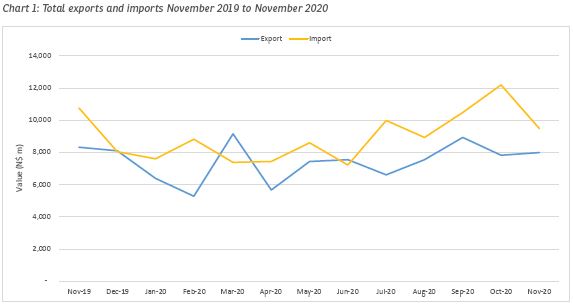
Trade balance continues to improve, mostly as a result of lower imports

The latest trade statistics released by the Namibia Statistics Agency show a slight month on month improvement in exports but a substantial weakening compared to a year ago.
The trade statistics for November 2020 show a 2.3% month on month increase in exports from October 2020 to November 2020 but it was still 3.9% less than in November 2019. Total exports amounted to N$7.8 billion, down from N$8.3 billion a year ago.
Following the trend, imports also fell, but by an even more significant 22.4% month on month, and by 12.1% year on year.
With November 2020 imports of N$9.5 billion, the trade balance continued to improve, registering a deficit of only N$1.4 billion which is significantly lower than the very large trade deficits of four years ago.
In the November 2020 trade statistics bulletin, the Statistician General, Mr Alex Shimuafeni said China is now Namibia most important export destination, demanding 41.3% of all goods exported. The second most important market, South Africa, has come down in export share, now only receiving about 14% of total exports. Other important markets are Botswana, Belgium and Germany.
On the import side, South Africa continues to be Namibia’s main supplier, accounting for more than 42% of all imports. Other important source markets are Zambia, Bulgaria and the DRC but these imports constitute mostly mineral which as destined for re-export. Only China is another important source of consumer and industrial goods.
Namibia’s biggest export commodities comprise the category non-ferrous metals, mostly copper and zink, which make up one quarter of all exports. Contributing another quarter are metalliferous ores and metal scrap. The other important exports are metallic mineral manufactures, non-monetary gold and fish.
The most important import commodities are non-ferrous metals (29.2%), metalliferous ores and metal scrap (7%), vehicles (6%), electrical machinery (2.8%) and iron and steel (2.7%).
More than half of all exports are done by sea with the rest more or less equally divided between air and road.
The overwhelming majority of goods imported came by road (80.4%), followed by sea (17.7%) and a small fraction by air (1.8%).











































